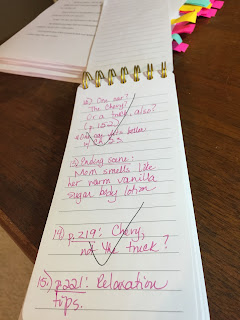 Virginia Woolf’s contention that writers must have a room of
their own may have been true back in the 1920s. Nowadays life pops in us no matter where we are, whether in the form of family, friends, and neighbors, or through our many (too many?) electronic devices.
Virginia Woolf’s contention that writers must have a room of
their own may have been true back in the 1920s. Nowadays life pops in us no matter where we are, whether in the form of family, friends, and neighbors, or through our many (too many?) electronic devices.Having an office or writing room doesn't guarantee uninterrupted inspiration. And for those of us with no dedicated writing space, the task of creating fiction can become even more tricky.
Fortunately, writing on the fly is easier now than it ever
has been. Cell phones with dictation capacity and note-taking apps provide
simple ways to capture our ideas whenever the Muse strikes. And with laptop
computers, writers can take their manuscripts, character Bibles, and meticulous
research anywhere they want.
With countless modern perks freeing up our writing
options, here’s 5 great reasons to write on the fly:
1. Our best writing can happen in the middle of living
 Most writers have a life, and it’s a good thing, too. Life
is brimming with story ideas we can miss out on when holed up in our favorite
writing spot.
Most writers have a life, and it’s a good thing, too. Life
is brimming with story ideas we can miss out on when holed up in our favorite
writing spot.
“Life is real! Life is
earnest! And the grave is not its goal” —Longfellow
Sometimes writers tend to forget that. Life passes us by while we’re fervently pouring our soul into our novels, only to look up bleary-eyed and blink, wondering where the day…the week…the month…has gone.
With that in mind, stretch. Take a break. Play with your
kids. Play with the neighbor’s kids. Getting your blood moving helps your brain
work better. Your unconscious is still busy at work, solving your novel’s
problems or plotting to rule the world. (It’s all the same, right?)
Having said that, few of us can leave our stories far
behind. I rarely go anywhere without my laptop. I know, I know…I may be
developing a disorder. But what if something happens and I end up stranded overnight with no one to talk to and nothing to do but write? (Yes,
my eyes are gleaming.)
This actually happened to me last October in a convergence
of freakish events involving a shredded tire, a city 45 miles from home, a free
hotel room, and my laptop. Who needs a fresh change of clothes as long as I can
write?
“Tomorrow may be hell, but today was a good writing day, and on
the good writing days, nothing else matters." –Neil Gaiman
2. Catch ideas when they come
As most writers know, great ideas can spring, fully formed,
into our minds at any moment. They can also disappear just as fast. Keep a
notebook with you at all times to jot down these gems.
Even better, use Evernote or another note taking app. Evernote is a great app that spans phones, tablets, PCs and macs. I use the free version.
For added convenience, try pinning a Story Ideas notebook to Shortcuts so you can easily add a note whenever an idea strikes. On some devices you can dictate the note, which is great for long commutes or jogs.
Even better, use Evernote or another note taking app. Evernote is a great app that spans phones, tablets, PCs and macs. I use the free version.
For added convenience, try pinning a Story Ideas notebook to Shortcuts so you can easily add a note whenever an idea strikes. On some devices you can dictate the note, which is great for long commutes or jogs.
3. Pick up snippets of dialogue
 Writing realistic dialogue can be tough. This is especially true
if your character’s POV differs from
Writing realistic dialogue can be tough. This is especially true
if your character’s POV differs from your own.
When writing in public, notice the varied ways people talk. Many use sentence fragments. Some make great use of slang. Others speak with complex sentence structure and multisyllabic words.
Can you spot someone who is like one of your characters? If so, you can channel that person when writing that character.
If you’re writing MG fiction, a buzz of young conversation around you can be a great source of inspiration. Use their dialogue to spark your imagination.
4. Study body language
While writing at the park or a game, observe people’s
tone of voice and body movement.
If you’re writing about 8-12 year old girls, notice how often they touch each other (a lot) and how (hugs, playing with each others’ hair, linking arms).
Boys in the same age group tend to be a bit more bouncy, more likely to trade a friendly shove.
If you’re writing about 8-12 year old girls, notice how often they touch each other (a lot) and how (hugs, playing with each others’ hair, linking arms).
Boys in the same age group tend to be a bit more bouncy, more likely to trade a friendly shove.
Note how people’s body language changes with their emotions.
Sometimes it’s easy to fall back on how we tend to respond. But everyone’s
different. For example, I’m not likely to shout at a referee. But I’ve got friends who will,
even if the ref isn’t out of line. Spending time with (and writing in the presence
of) a wide variety of people can add a rich dose of reality to your work.
5. Make the most of your time
 Unless you are one of the few writers who lives off their
novels, you’re probably working a job or two, maybe three. You may be in school
or have a family.
Unless you are one of the few writers who lives off their
novels, you’re probably working a job or two, maybe three. You may be in school
or have a family.Needless to say, writing time comes at a premium. It is precious, carved out of scarce free moments. So use chunks of downtime to your advantage.
Waiting in the doctor’s office? Jot down some brainstorming or do a bit of editing. “Watching” football practice? Bust out a short story. Got ten minutes before the kids finish school? Start a character interview.
You get the idea. These little bits of time can add up to
something wonderful, if you’re prepared. Make a plan. Bring a notebook, tablet,
or laptop, whatever works for you. Then be ready to work. Because the more time
you put in, the more stories and novels you’ll have to show for it.
Happy writing!









